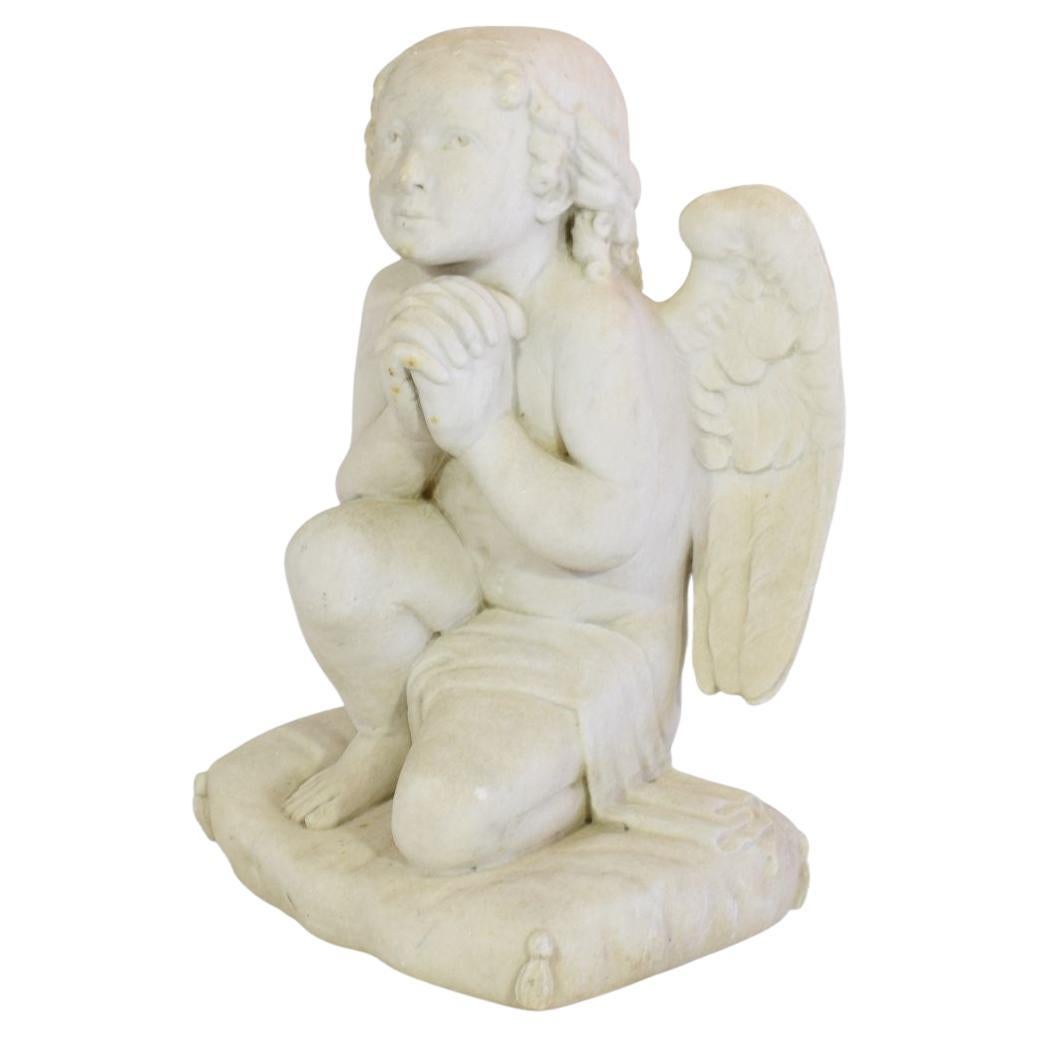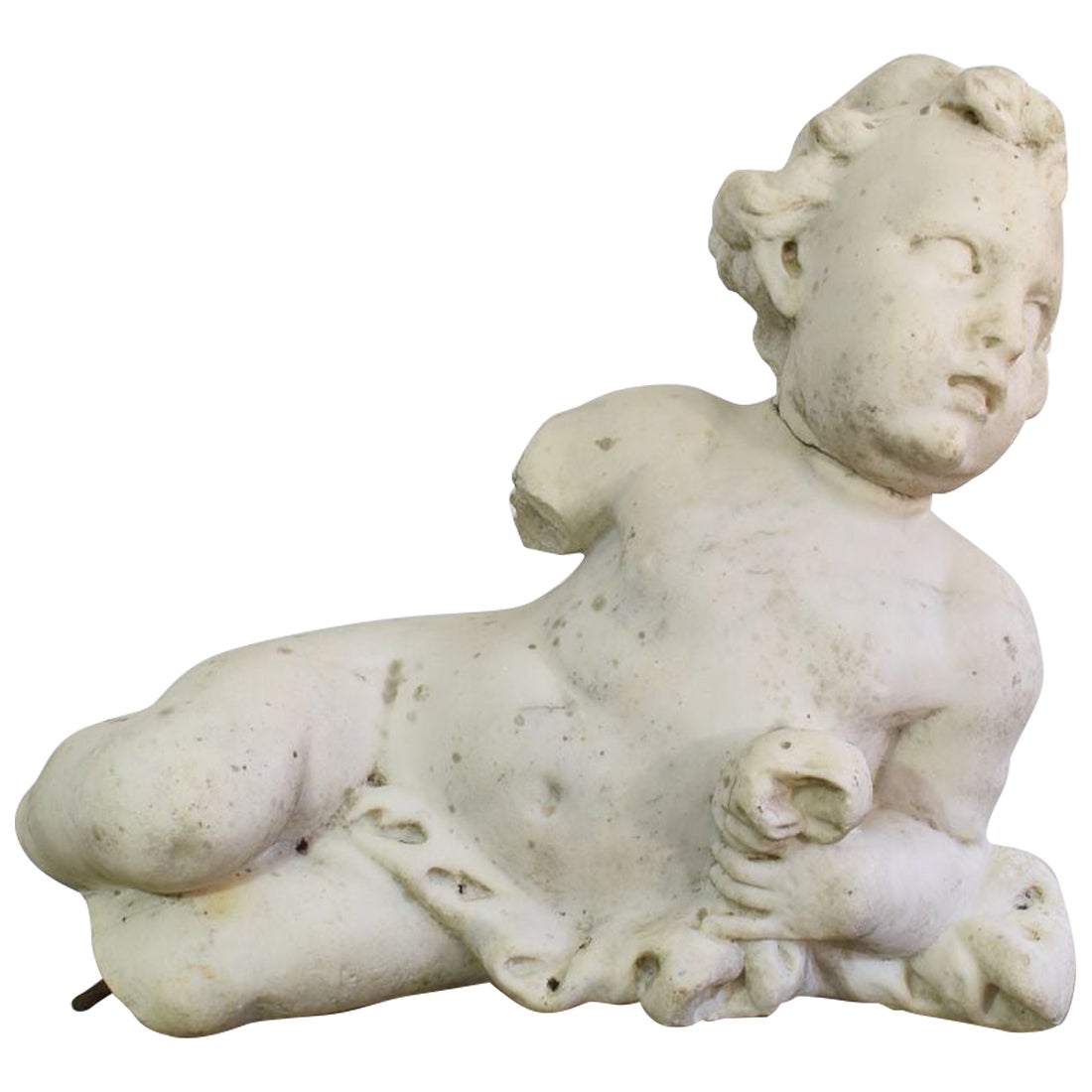Items Similar to Palatial Pair of English Baroque Style 19th Century Carved Marble Sitting Lions
Want more images or videos?
Request additional images or videos from the seller
1 of 11
Palatial Pair of English Baroque Style 19th Century Carved Marble Sitting Lions
About the Item
A very fine and palatial pair of English Baroque style 19th century carved marble sitting lions, the very realistic carved pair with fine attention to detail, each resting its front two paws on a coat-of-arms shield carved with the emblem of two ladders joined by crossed sword. Unsigned, circa 1880.
Measures:
Height: 47 1/2 inches (120.7 cm).
Width: 25 inches (63.5 cm).
Depth: 31 inches (78.8 cm).
- Dimensions:Height: 47.5 in (120.65 cm)Width: 25 in (63.5 cm)Depth: 31 in (78.74 cm)
- Sold As:Set of 2
- Style:Baroque (In the Style Of)
- Materials and Techniques:
- Place of Origin:
- Period:
- Date of Manufacture:circa 1880
- Condition:Wear consistent with age and use. Minor losses. Minor fading. A truly beautiful and impressive pair of Royal guarding lions. Both are weathered with some minor chipping, old paint residue and erosion hairline cracks as expected for these type of outdoor sculptures. Great for a Grand entrance or by the poolside.
- Seller Location:Los Angeles, CA
- Reference Number:
About the Seller
5.0
Vetted Seller
These experienced sellers undergo a comprehensive evaluation by our team of in-house experts.
Established in 1982
1stDibs seller since 2016
114 sales on 1stDibs
Typical response time: <1 hour
- ShippingRetrieving quote...Ships From: Los Angeles, CA
- Return PolicyThis item cannot be returned.
More From This SellerView All
- Palatial Pair of French Baroque Style 19th Century Carved Marble Sitting LionsLocated in Los Angeles, CAA Very Fine and Palatial Pair of French Baroque Revival Style 19th Century Carved Marble Sitting Lions, the very realistic carved pair of posing lions with fine attention to detail, ...Category
Antique Late 19th Century French Baroque Revival Animal Sculptures
MaterialsMarble
- Monumental Pair of French 19th-20th Century Putto Flambeaux Urns TorcheresBy René Rozet 1Located in Los Angeles, CAMonumental pair of French 19th century figural gilt and patinated bronze Rosso Granite marble Flambeaux Urns Torcheres, each depicting a pair of allegorical Putti (Children) holding ...Category
Antique 1890s French Louis XV Figurative Sculptures
MaterialsGranite, Bronze
- Pair of French 19th Century Lifesize Cast-Iron Sculpture Torcheres, Val d'OsneBy Val D'Osne FoundryLocated in Los Angeles, CAA superb quality and palatial pair of French 19th century lifesize cast-iron sculptures - torcheres of Native American Indians titled "L’ Indienne" designed by Jules Salmson (French, 1823-1902) and Cast by Le Fonderies d'Art du Val d'Osne, each standing figure representing a Native American Indian male and a female scantily dressed in their native robes, one arm raised holding a light-torch with an opaline glass globe, both wearing earrings, seashell necklaces and arm-braces, raised on cylindrical cast-iron stand. Signed/cast on each pedestal: “VAL D’OSNE”. (Electrified). Paris, circa 1870-1880. Overall hHeight: 127 inches (322.6 cm) Pedestal height: 39 inches (99.1 cm) Indian man's width: 22 inches (55.9 cm) Indian man's depth: 26 3/4 inches (68 cm) Indian woman's width: 28 inches (71.1 cm) Indian woman's depth: 25 inches (63.5 cm) These fantastic and impressive pair of cast-iron sculptures, most likely representing Hiawatha and Minnehaha, were probably comissioned to Le Fonderies d'Art du Val d'Osne for export to the America's to decorate governmental buildings and parks which makes these pair a rare find and now available for a private collection. Iron sculptures were preferred over bronze for outdoor park and building decorations for their long lasting resistance to all types of weather conditions. An identical pair of sculptures, also by Val d' Osne, are currently exhibited at the National Garden of Congress in Santiago, Chile. View Pages No. 87, 88, 89. Another identical pair are also currently exhibited at The Musée de la Ville - Indian Museum "O Indio do Museo da Cidade" in Rio de Janeiro, Brazil. Another identical pair decorate the front of the Ópera Teatro Amazonas, Manaús, Brazil. A single figure of the female Indian...Category
Antique 19th Century French Tribal Figurative Sculptures
MaterialsIron
- Pair of Palatial Venetian Walnut Carved Mid-19th Century Baroque Figural ThronesBy Valentino BesarelLocated in Los Angeles, CAA very fine pair of palatial Venetian walnut carved mid-19th century Baroque figural throne armchairs, attributed to Valentino Panciera Besarel (Venice, 1829-1902) in the manner of Andrea Brustolon (1662-1732). The ornately carved thrones, each flanked with figures of standing males supporting a branch-carved armrests with vines. Raised on cabriolet scrolled legs. Provenance: The Castello di Giove in Umbria, Italy, circa 1870-1880. Height: 54 1/4 inches (137.8 cm.) Width: 37 1/4 inches (94.6 cm.) Depth: 32 inches (81.3 cm.) Andrea Brustolon (20 July 1662 – 25 October 1732) was an Italian sculptor in wood. He is known for his furnishings in the Baroque style and devotional sculptures. Biography He was trained in a vigorous local tradition of sculpture in his native Belluno, in the Venetian terraferma, and in the studio of the Genoese sculptor Filippo Parodi, who was carrying out commissions at Padua and at Venice (1677). He spent the years 1678-80 at Rome, where the High Baroque sculpture of Bernini and his contemporaries polished his style. Apart from that, the first phase of Brustolon's working career was spent in Venice, 1680–1685. Brustolon is documented at several Venetian churches where he executed decorative carving in such profusion that he must have quickly assembled a large studio of assistants. As with his contemporary in London, Grinling Gibbons almost all the high quality robust Baroque carving in Venice has been attributed to Brustolon at one time or another. In the Venetian Ghetto, at the Scola Levantina, Brustolon provided the woodwork for the synagogue on the piano nobile, where the carved, canopied bimah is supported on Solomonic columns, which Brustolon had seen in Bernini's baldacchino in the Basilica of St Peter's. His furniture included armchairs with figural sculptures that take the place of front legs and armrest supports, inspired by his experience of Bernini's Cathedra Petri. The gueridon, a tall stand for a candelabrum, offered Brustolon unhampered possibilities for variations of the idea of a caryatid or atlas: the familiar Baroque painted and ebonized figural gueridons, endlessly reproduced since the eighteenth century, found their models in Brustolon's work. His secular commissions from Pietro Venier, of the Venier di San Vio family (a suite of forty sculptural pieces that can be seen in the Sala di Brustolon of the Ca' Rezzonico, Venice), from the Pisani of Strà, and from the Correr di San Simeone families encourage the attribution to him of some extravagantly rich undocumented moveable furniture. Andrea Brustolon's elaborate carved furniture aspired towards the condition of sculpture, such as the Dutch bases for console tables which look like enlargements of the work of the two Van Vianens, Paulus and Adam, perhaps the greatest Dutch silversmiths of the period. These carved pieces display the baroque tendency to develop a form three-dimensionally in space. Brustolon's walnut, boxwood and ebony pieces transcend ordinary functional limitations of furniture; they are constructed of elaborately carved figures. The framework of Brustolon's chairs, side tables and gueridons were carved as gnarled tree branches, with further supports of putti and male figures carved in ebony. Backrests of the chairs, which were never touched in the rigidly upright posture that contemporary etiquette demanded, were carved with allegories of vanity, fire and music, etc. The most extravagant piece delivered for Pietro Venier was a large side table and vase-stand of box and ebony, designed as a single ensemble to display rare imported Japanese porcelain vases. The eclectic allegories include Hercules with the Hydra and Cerberus, males and reclining river-gods (see ref.). For the Correr, less extrovert chairs bear female nudes extended along the armrests. For the Pisani, he carved a suite of twelve chairs (now at the Palazzo Quirinale) with flowers, fruit, leaves and branches to symbolize the twelve months of the year. Work by Brustolon is at the Villa Pisani at Stra. In 1685 Brustolon returned to the house where he was born at Belluno, and from that time devoted himself mainly to tabernacles and devotional sculptures in walnut, boxwood or ivory. His polychromed ivory Corpus from a crucifix is in the Museo Civico di Belluno, which preserves some of Brustolon's preparatory drawings for frames to be carved with putti displaying emblems. A pair of boxwood sculptures, The Sacrifice of Abraham and Jacob Wrestling with the Angel...Category
Antique 19th Century Italian Baroque Armchairs
MaterialsLeather, Walnut
- Palatial Italian 19th Century Baroque Style Giltwood Carved Florentine MirrorLocated in Los Angeles, CAA fine Palatial Italian, 19th century baroque style vigorously carved Florentine giltwood mirror frame. The ornately carved frame with scrolls, acanth...Category
Antique Late 19th Century Italian Baroque Revival Wall Mirrors
MaterialsWood
- Italian 19th Century Carved Carrara Marble Figural Fountain Jardinière PlanterBy Giovanni Battista LombardiLocated in Los Angeles, CAA very fine Italian 19th century carved Carrara marble figural fountain "Jardinière" modelled as a standing Putto and a Satyr supporting a sea-sh...Category
Antique 19th Century Italian Baroque Figurative Sculptures
MaterialsCarrara Marble
You May Also Like
- Pair of 19th Century Sandstone LionsLocated in Essex, MAPair of 19th century French sandstone lion fragments. Well carved and with very endearing features. Though fragmentary, these lions present as importan...Category
Antique Late 19th Century French Baroque Statues
MaterialsSandstone
- 19th Century European Lion of Hand Carved StoneLocated in Atlanta, GAA European carved stone lion from the 19th century, or potentially older. This antique stone lion statute features nice hand carved details, includ...Category
Antique 19th Century European Statues
MaterialsStone
- Pair of Hand-Carved 19th Century Italian Marble LionsLocated in Port Jervis, NYHand-carved pair of Carara marble, 19th century, Italy, darkened from age, very heavy weighing about 175lbs each. Some minor chips to marble. In good shape overall.Category
Antique Late 19th Century Italian Baroque Revival Statues
MaterialsCarrara Marble
- 19th Century French Carved White Marble AngelLocated in Buisson, FRBeautiful hand carved marble angel. Made out of one piece, France, circa 1850. Weathered and small losses. More pictures are available on request.Category
Antique 19th Century French Figurative Sculptures
MaterialsMarble
- Pair 19th c Sculpted Wood LionsLocated in New Orleans, LAA pair of recumbent lions curved together, set on shaped base.Category
Antique Late 19th Century French Statues
MaterialsWood
- Fine Pair of Carved Marble Garden Foo Lion FiguresLocated in Bridgeport, CTA pair of opposing foo lions with elaborately carved curled fur and seated on bases. One places a paw on a ball, the other on an upside down baby foo lion. Overall fine time worn sur...Category
Mid-20th Century Ming Statues
MaterialsMarble
Recently Viewed
View AllMore Ways To Browse
Carved Pair
Antique Sitting Room Furniture
Gray Baroque
English Baroque
Baroque Marble
English Baroque Furniture
Pair Of Carved Lions
Coat Of Arms England
Arms Shield
Marble Carved Lions
Baroque Cross
Lion With Shield
Coat Of Arms Carved
Marble Lion Paw
Coat Of Arms Pair
Pair Of Coat Of Arms
English Coat Of Arms
Coat Of Arms Lions





